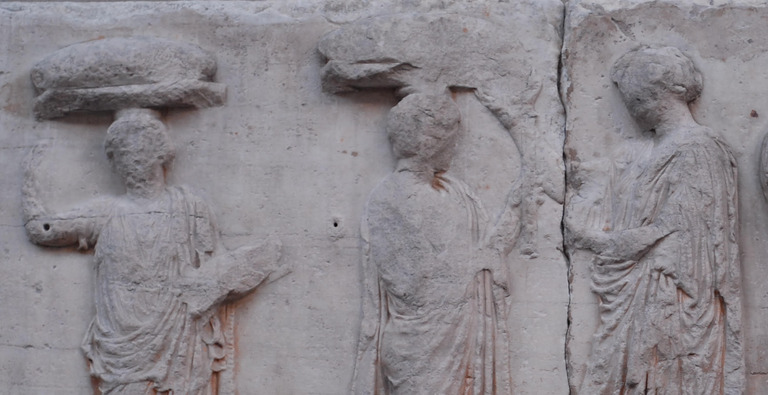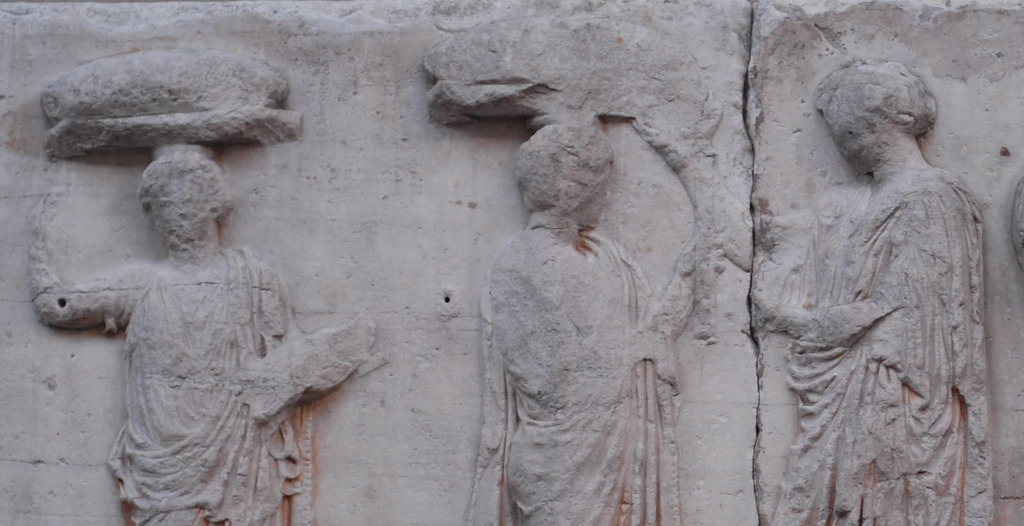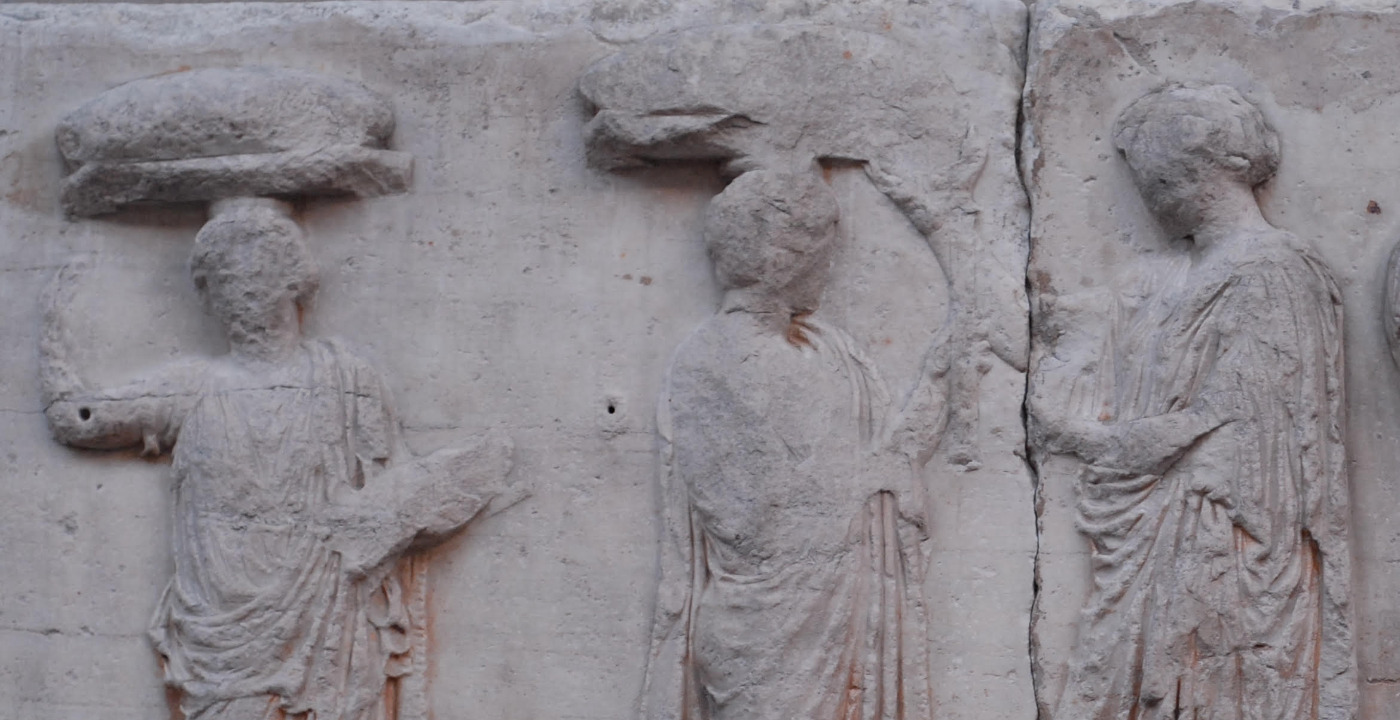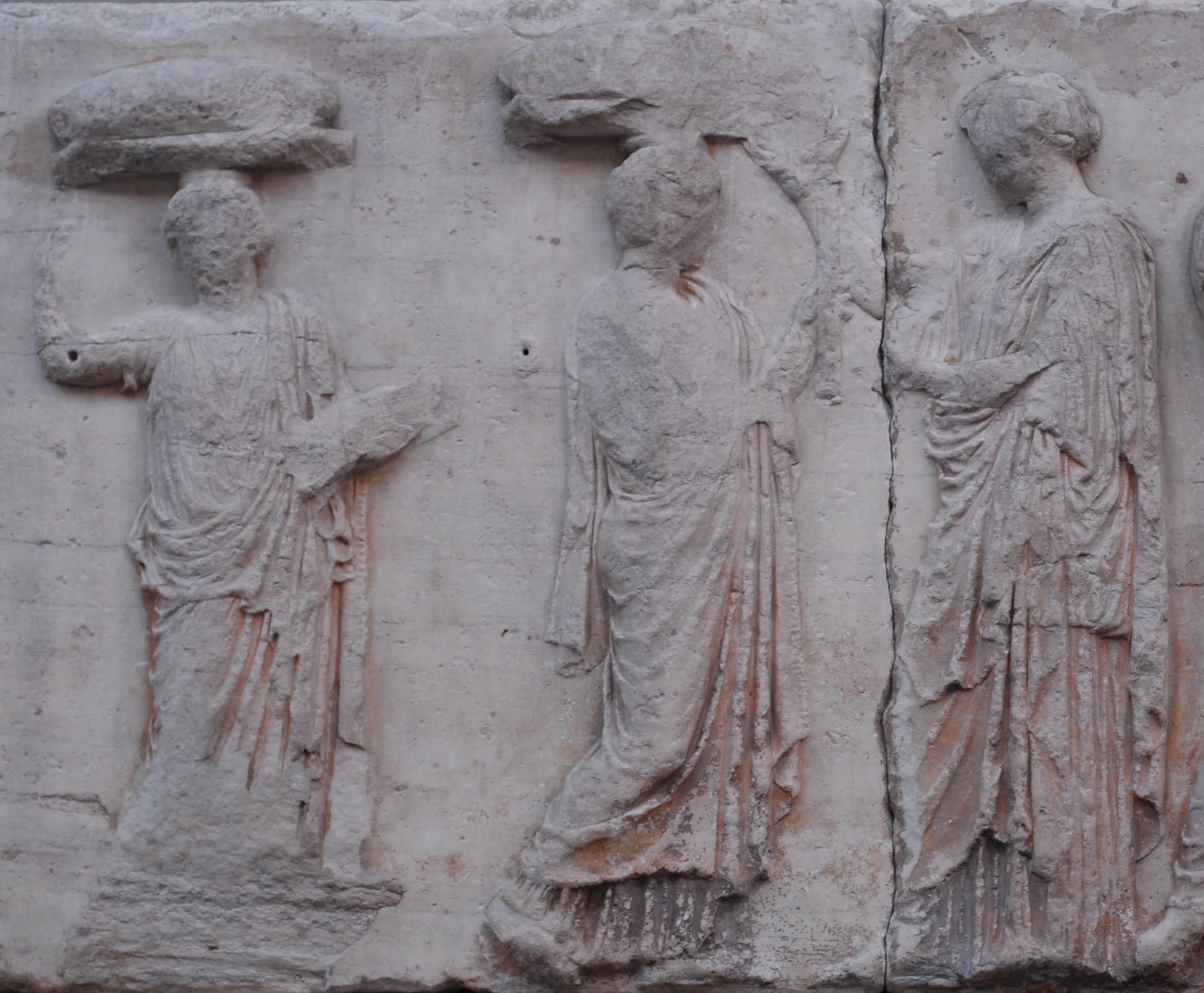Birth
458 BCE.
Education
Probably home schooled.
Death
370 BCE.
Lysimache’s precise dates of birth and death are uncertain. Her epitaph, dated about 370 BCE (IG II² 3453), states she lived for 88 years.
Religion
PaganismLysimache was a priestess of Athena Polias. She lived in Athens in the 4th and 5th centuries BCE and was born to a noble family, enabling her to take up the most important priesthoods in the city at twenty-four, a position she held for sixty-four years. She is the first known example of a freestanding portrait statue of a priestess on the Acropolis, the most important religious space in Athens. This was a formal honor that only the Athenian government could award.
Though little is known of her particular actions, it is known that as the priestess of Athena Polias, Lysimache established such a positive reputation for herself that the city publicly honored her, and that she saw the city through one of its most turbulent times in its history.
Personal Information
Name(s)
Lysimache
Family
Mother:
An Athenian (no other information available).
Father:
Drakontides of the Attic deme Bate.
Marriage and Family Life
Lysimache’s genos [noble family] on her father’s side was of high status, a branch of the Eteoboutidai family which traced its ancestry back to a mythical hero, Boutes. This genos held two of the most important and prestigious hereditary priesthoods in Athens, the priesthood of Athena Polias and the priesthood of Poseidon.
Her brother was Lysikles son of Drakontides of Bate; he held an important government role in Athens as secretary of the Treasurers of Athena in 416/5 BCE.
Lysimache was married to an Athenian from the deme Phlya; his name is not preserved.
She lived to see ‘four generations of children’ (IG II² 3453 l. 4). This included at least one son; his name has been lost (only the final three letters of his name remain on the stone).
Education
There is no specific information about her education. The education of Athenian women is poorly attested: women are believed to have been largely home schooled. For the evidence, see Beck 1975, p. 55-62.
Religion
Paganism
Transformation(s)
Lysimache was the priestess of Athena Polias (‘Athena of the City’). Athena, in this aspect, was the tutelary (protecting) god of Athens. Her temple was on the acropolis of Athens and she was the most important deity of the city. The priestess of Athena Polias was the most important religious person (male or female) in Athens, a city in which religion was a significant aspect of community definition and an important part of everyday life. This was the most prestigious role that a woman could hold in Classical Athens.
This priesthood was gentilician; the appointee had to come from the genos Eteoboutidai. It is unclear how the appointment was made: on merit from a member of the genos, by primogeniture from a particular line of the genos, or by lot from qualified women in the genos. The priestess held the position for life; we do not know if there was a minimum age for appointment though it appears to be a role held by adult women. Lysimache was 24 when she was appointed and she held the position for 64 years (IG II² 3453 l. 3; Pliny NH 34.76).
The priestess of Athena Polias had a key role in the ritual whenever sacrifices were made to Athena on the acropolis. She led the sacrifices at the Erechtheion, where the archaic cult statue of Athena Polias was housed (IG I3 474.1). There was a throne for the priestess in the adyton (inner chamber) of her temple (Hdt. 5.72). Her role was not restricted to worship on the acropolis. A later source describes an annual parade as part of the Athenian celebration of the Skira festival which was led by the priestess of Athena Polias.
Contemporaneous Network(s)
The priestess of Athena Polias had two assistants who were also women: the Kosmo and Trapezophoros. These roles were also prestigious. An inscription has survived on the base of a statue dedicated for Syeris ‘the assistant (diakonos) of Lysimache’ (IG II2 3464). The statue itself has not survived, but Pausanias who saw it on the Acropolis in the second century CE (1.27.4) describes it as about a cubit high (about half a metre) and depicting Syeris as an elderly woman (presbytis) (see Keesling 2012). Such archaeological evidence for two women who worked together in Classical Athens is rare.
The priestess of Athena Polias supervised Arrephoroi, girls from noble families who participated in religious rituals deemed important for the city. They were aged 7-10 and their religious duties included taking up the weaving of a new peplos for Athena that was presented at the Panathenaia (Athens’ most important festival). This is illustrated in centre of the Parthenon frieze (slab V, §§31-5) which depicts the citizens of Athens processing to the Acropolis in the Panathenaia. In fact, at the very centre of the frieze, with the gods sitting either side, is the priestess of Athena Polias (§33) with two Arrephoroi. The priestess of Athena Polias also conducted a nighttime ceremony at the festival of the Arrephoria, at which the Arrephoroi carried on their heads sacred and secret objects.
The priestess would have been known to all Athenians as she had sacrificial duties to perform when a child born and when a citizen died ([Arist.] Econ. 2.2.4, 1347a). She also visited women who had recently married, wearing when she did so the sacred aigis (usually understood as a garment made from a skin) believed to have been worn by Athena (Suda alphaiota 60).
less
Significance
Contemporaneous Identifications
Aristophanes has his protagonist pray to Peace as a goddess and call on her to be ‘a true Lysimache to us’ (Peace 992: 421 BCE). The play was produced when Lysimache would have been priestess of Athena Polias and we can expect the audience to have both recognised the reference to her and been able to identify her in the theatre. While scholarship dating back to eighteenth century Germany wants to exclude all women from attending performances in Athens on social and political grounds [Goldhill 1994; see Katz 1998], theatre was a central component of religious festivals in which women participated [Henderson 1991], and women are explicitly acknowledged as part of the audience in Aristophanes’ Lysistrata 1050-51 [Sommerstein 1990]. We can expect Lysimache herself to have been one of those women as there is evidence that the priestess of Athena Polias had a designated seat of honour in the theatre of Dionysus. Seats with the name of the priestess inscribed on them have survived from a later period and, given the conservative nature of religious ritual, this probably reflects earlier practice. Names of priestesses surviving on these seats are: Athenion (IG II² 5063a); Philippe (IG II² 5104); Megiste (IG II² 5105 and IG II² 5107 with IG II² 3173).
A statue was made of Lysimache (which has not survived) by Demetrios with an epitaph inscribed on the base (IG II2 3453; Pliny NH 34.76). The base is circular and would have supported a bronze statue about two-thirds life size. Demetrios was an Athenian sculptor and contemporary of Lysimache. Work by him (all now also lost) is described as naturalistic in style, suggesting his statue of Lysimache was likely to have been naturalistic too.
Reputation
Pliny, writing in the first century CE, comments on the length of Lysimache’s service in her role, indicating just how noteworthy this was (Pliny NH 34.76).
Plutarch (Mor. 534c) quotes Lysimache, attributing to her a witty response that suggests that she defended traditional ritual practice. While we cannot be sure that the anecdote preserves an actual historical conversation, at the very least it reflects an idea of what Lysimache may have been like, drawn from the reputation that she in particular or perhaps women in this role in general gained in preserving religious traditions. That Lysimache is even remembered and named by Plutarch reflects the strength of her personal reputation, something her long service in this role may have fomented.
Herodotus, who was writing when Lysimache held her priesthood, makes the priestess of Athena Polias an authoritative member of the Athenian community whose views were of great weight. He describes how in 507 BCE a predecessor of Lysimache stood up to a Spartan king who attempted to enter the inner chamber of Athena’s temple and ordered him out (Hdt. 5.72.3-4). In another example, Herodotus depicts the priestess of Athena Polias making the crucial determination in 480 BCE that Athena had left the city, paving the way for the evacuation of Athens that saved the population from capture by the Persians (Hdt. 8.41.33).
Legacy and Influence
Lysimache’s is the first known example of a freestanding portrait statue of a priestess on the Acropolis, the most important religious space in Athens. This was a formal honour that only the Athenian government could award. While we are not told specifically what she achieved during her time in her role, her service of 64 years was exceptional and may, in part, explain the recognition.
During her time in office, Athens faced a serious plague which required, in accord with contemporary beliefs about illness, a religious solution. Athens also suffered from a long and costly war (in lives and resources) which they ultimately lost. After the loss, the Acropolis, home of Athena’s temple at which Lysimache presided, was occupied for a time by the victorious Spartans. As the most important priestess of the protecting deity of the city, Lysimache would have had to maintain the city’s good standing with that goddess during those dark times for the Athenians. That she was accorded public recognition for her service over this period indicates the Athenian community approved of the way she had conducted vital religious ceremonies on their behalf during those times.
less
Controversies
Controversy
Lewis (1955) argued that Lysimache was the inspiration for the character Lysistrata in Aristophanes’ play of the same name and that he had modelled his heroine on her. This identification has been widely accepted (Thonemann 2020). The comedy was presented in 411 BCE when Lysimache would already have held her office for over ten years. The first syllable of the two names are the same, and as words they mean much the same thing: ‘Destroyer/dissolver of Battle’ (Lysimache) and ‘Destroyer/dissolver of Armies (Lysistrata). In the play, Lysistrata unites the women of Athens with women from the Greek states Athens had been fighting for twenty years to demand an end to the war. The women seize and hold the Athenian Acropolis, the place where Lysimache performed her role as the city’s religious leader. The setting of the play, along with Lysistrata’s name, would recall the real Lysimache to the audience in the theatre. Further, Aristophanes’ Lysistrata makes the comparison explicit, saying: “I believe that one day among the Greeks we will all be called Lysimaches” (l. 554).
In addition, it is worth noting that another character in the Lysistrata also shares her name with a significant priestess who was in office at the time of the performance: Myrrhine. She was the first priestess of Athena Nike at Athens and had been in office for over 36 years or over 12 years at date of the performance of the Lysistrata (the dating of the start of her priesthood is uncertain: either 448 or about 424 BCE: IG I3 35 and IG I3 36; IG I3 1330).
Women had no formal political voice in ancient Athens. The idea of women taking revolutionary political action under the strong and effective leadership of Lysistrata was, in its day, both controversial and fantastic, yet grounded in reality with the sincere call for an end to war put into the mouths of women, led by a woman readily identified as the priestess of the city’s tutelary god.
New and Unfolding Information and/or Interpretations
While the identification of Lysistrata with Aristophanes’ Lysimache is generally accepted, it is unclear how far we can push the comic persona as a representation of the real woman. The protagonist of Aristophanes’ play is a social and political activist. Lysistrata is a woman of authority, a leader who stands up to men: this may well reflect the character of the woman on which she was drawn.
Lysistrata rejects war and leads the women in revolt against the men of Hellas to achieve peace. Under her leadership, women break out of their normal roles, including their duties as wives and mothers. Their actions include seizing the sacred sites of Athens on the Acropolis as well as instigating a sex strike (Lysistrata 119-124, 829-953). The women confront and overcome the men who try to take back the Acropolis by force (Lysistrata 241-242, 350-386). They also seize control of the Athenians’ silver reserves, financial resources needed for the war, which were stored in Athena’s temple (an action that appears to reference an aspect of Lysimache’s duties as Athena’s priestess: Lysistrata 421-423, 489-492 with Thonemann 2020). In these actions they subvert traditional Athenian expectations of female behaviour. The authority that Lysistrata shows over the women of Athens, along with women she summons from Sparta, Boeotia, and Corinth, should not be overlooked or passed off as part of the comic scenario: such authority might be expected in a woman from one of the elite families of Athens, particularly in one who held the most important religious office of the state.
Modern critics of the play have tended to focus attention on the comic sexual motivation given for the women’s actions. Yet Lysistrata points to a serious contemporary issue that women faced in having to send their sons off to die in battle. Lysistrata voices this concern and provides a religious argument against war: that the Athenians and Spartans share common religious festivals, just as a family does. She also argues that each state has, in the past, been of great service to the other, and they must stop fighting (Lysistrata 588-90; 1124-1135; 1137-1146; 1149-1156). That ten years earlier Aristophanes had called on Peace to be a true Lysimache is no coincidence. In a role that draws strength from the audience’s recognition of the character on stage as the priestess of Athena, we can infer that these were views believed to have been held by Lysimache too. As a person who stood for peace, a public opponent of the state’s policy to pursue war, Lysimache herself must have been a true leader and a woman of great strength of character.
less
Bibliography
Primary (selected):
IG II² 3453 Inscriptiones Graecae II et III: Inscriptiones Atticae Euclidis anno posteriores, 2nd edn., Parts I-III, ed. Johannes Kirchner. Berlin 1913-1940. https://epigraphy.packhum.org/text/5730?&bookid=5&location=1701
Attic Inscriptions (trans. S. Lambert): https://www.atticinscriptions.com/inscription/IGII2/3453
Archival Resources (selected):
Beck, F. A. G. 1975, An Album of Greek Education, Sydney.
Blok, J. H. & Lambert, S. D. 2009, “The Appointment of Priests in Attic gene,” ZPE 169, pp. 95-121.
Dillon, M. 2002, Girls and Women in Classical Greek Religion, London & New York.
Goldhill, S. 1994. “Representing Democracy: Women at the Great Dionysia”, in Ritual, Finance, Politics: Athenian Democratic Accounts Presented to David Lewis, ed. R. Osborne and S. Hornblower, Oxford, pp. 347-69.
Henderson, J. 1991, “Women and the Athenian Dramatic Festivals,” Transactions of the American Philological Association 121, pp. 133- 147.
Katz, M. A. 1998, “Did the Women of Ancient Athens Attend the Theater in the Eighteenth Century?” Classical Philology 93.2, pp. 105-124.
Keesling, C. M. 2012, “Syeris, Diakonos of the Priestess Lysimache on the Athenian Acropolis (IG II 2 3464),” Hesperia 81. 3, pp. 467-505.
Lambert, S. 2019, “The Priesthoods of the Eteoboutidai,” in The Power of Individual and Community in Ancient Athens and Beyond. Essays in Honour of John K. Davies, ed. Z. Archibald and J. Haywood, pp. 163-176.
Lewis, D. M. 1955, “Notes on Attic Inscriptions (II): XXIII Who Was Lysistrata?” ABSA 50, pp. 1-36.
Sommerstein, A. H. 1990, Lysistrata, Warminster.
Thonemann, P. 2020, “Lysimache and Lysistrata,” JHS 140, pp. 128-142.
Issues with the Sources
Women’s lives are not well attested in Ancient Greece. Our primary knowledge of Lysimache comes from her epitaph, which was brief and is now incomplete. Our knowledge is helped by references to her or her memorial in antiquity, but these too are brief. Identification of her in the contemporary comedies of Aristophanes adds important information, but this is filtered by the comic genre and must be interpreted with care.




Comment
Your message was sent successfully